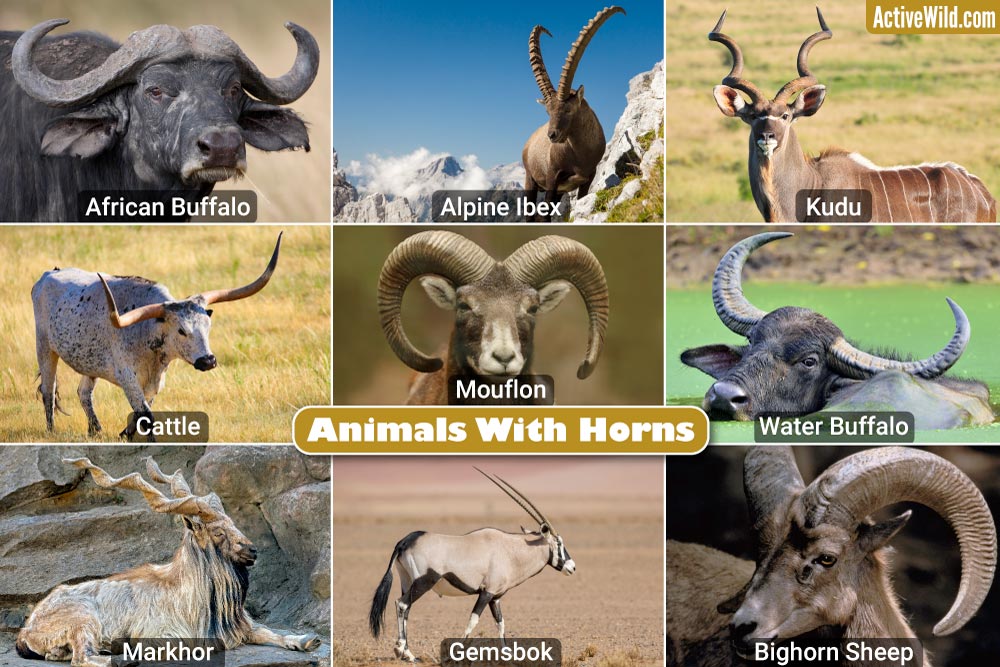Animals with horns include the American and European bison, Asian water buffalo, African buffalo; antelopes such as the springbok, blackbuck, saiga, impala, gazelles, dik-diks, oryxes and wildebeest; the yak, gaur, ibexes, muskox and domestic cattle, sheep and goats. All animals with true horns belong to the family Bovidae.
Animals with features that resemble horns, but which aren’t “true” horns, include other hooved animals such as rhinos and giraffes, and species from unrelated groups, such as horned lizards, chameleons and horned vipers.
On this page you’ll find information on animal horns, followed by a list of animals with horns – which includes pictures of some of the most amazing horns in the entire animal kingdom!
Page Index
- What Are Horns?
- What Animals Have Horns?
- Which Animal Has The Longest Horns?
- Which Animal Has The Shortest Horns?
- Which Animal Has The Most Horns?
- Horns Vs Antlers
- Why Do Animals Have Horns?
- Further Reading
Examples Of Animals With Horns
- Addax
- African Buffalo
- Alpine Ibex
- American Bison / Buffalo
- Bighorn Sheep
- Bharal / Blue Sheep
- Cattle
- Four-Horned Antelope
- Gaur / Indian Bison
- Gemsbok
- Giant Eland
- Greater Kudu
- Impala
- Markhor
- Mouflon
- Nubian Ibex
- Pronghorn
- Scimitar Oryx
- Royal Antelope
- Saiga
- Water Buffalo
- Wild Water Buffalo / Asian Water Buffalo
Animals With “Horns” That Aren’t “True” Horns!
- Rhino
- Deer
- Giraffe & Okapi
- Horned Lizards
- Horned Owls
- Horned Vipers
- Jackson’s Chameleon / Three-Horned Chameleon
Further Reading
What Are Horns?
Horns are hard, pointed structures that grow in pairs on the heads of many hooved animals. Horns are permanent growths that have a central core made of bone, which is surrounded by a keratin sheaf.
Keratin is a tough, flexible, naturally-occurring substance found in many animals (including humans). Body parts such as nails, hair, feathers and hooves – as well as the outer layer of horns – are made of keratin.
An animal’s horn begins to grow soon after it is born, and continues to grow throughout the animal’s life.
What Animals Have Horns?
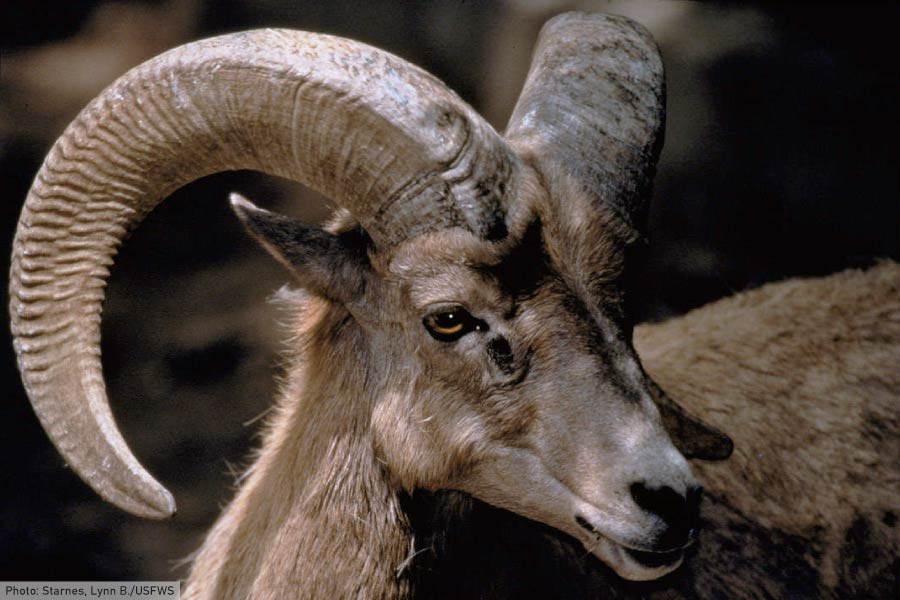
“True” horns, that is, structures with a bony core surrounded by a keratinized sheath, are found only on hooved animals in the families Bovidae and Antilocapridae.
The family Bovidae, whose members are known as “bovids”, contains all antelopes, cattle, bison, buffalo and goat-antelopes (animals such as sheep, goats, muskoxen and ibexes, etc.). The family Antilocapridae contains only one living species: the pronghorn.
The horns of reptiles such as horned lizards also fulfil the above criteria, and could be regarded as “true” horns. Usually, however, true horns are seen as a mammalian characteristic.
Further down the page is a list of animals with horns.
Do Female Animals Have Horns?
Horns are more often found on male animals. Only in around half of all bovid genera do females have horns.
Even in species in which both sexes have horns, those of the male are often larger and sturdier than those of the female.
This is because the males of many species of horned animal use their horns to fight rival males of the same species. Fighting establishes dominance within a herd, and success can increase a male animal’s likelihood of mating. Therefore, over time, males evolve bigger horns.
Other Horned Animals
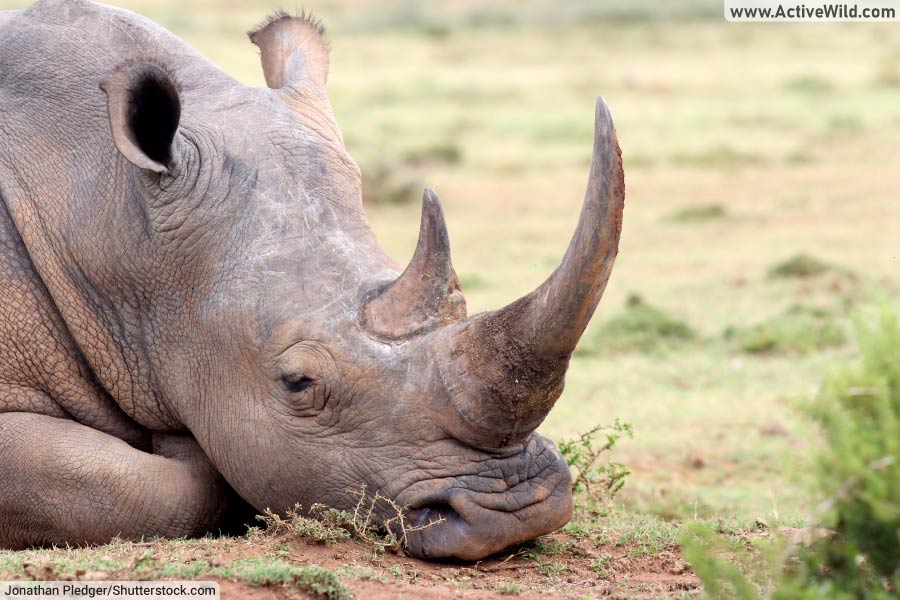
Many other animals have horn-like structures which, despite being called “horns”, are not the “true” horns such as those found in bovids. A rhino’s horn, for example, lacks the bony center of a true horn. You can see examples of other horned animals in a list further down the page.
Which Animal Has The Longest Horns?
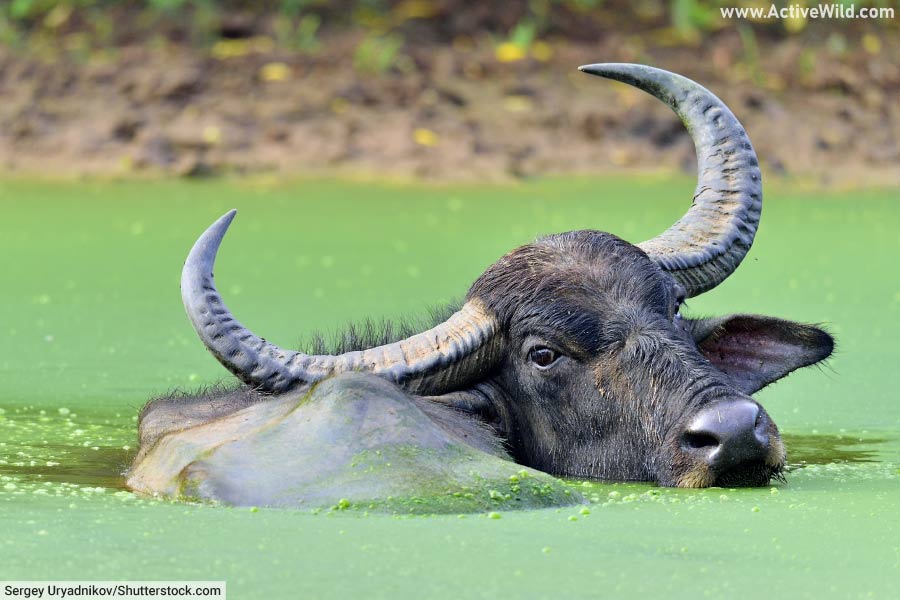
The animal with the longest horns is the wild water buffalo, Bubalus arnee. Also known as the Asian buffalo, this species is found in several southern and Southeast Asian countries. Its horns can reach an amazing 2 m / 6.5 ft in length (when measured along the outside edge), and the maximum recorded tip-to-tip length of both horns is 4.24 m / 13.9 ft. (Source: Guinness Book of Records)
The conservation status of the wild water buffalo is Endangered. (Source)
Which Animal Has The Shortest Horns?
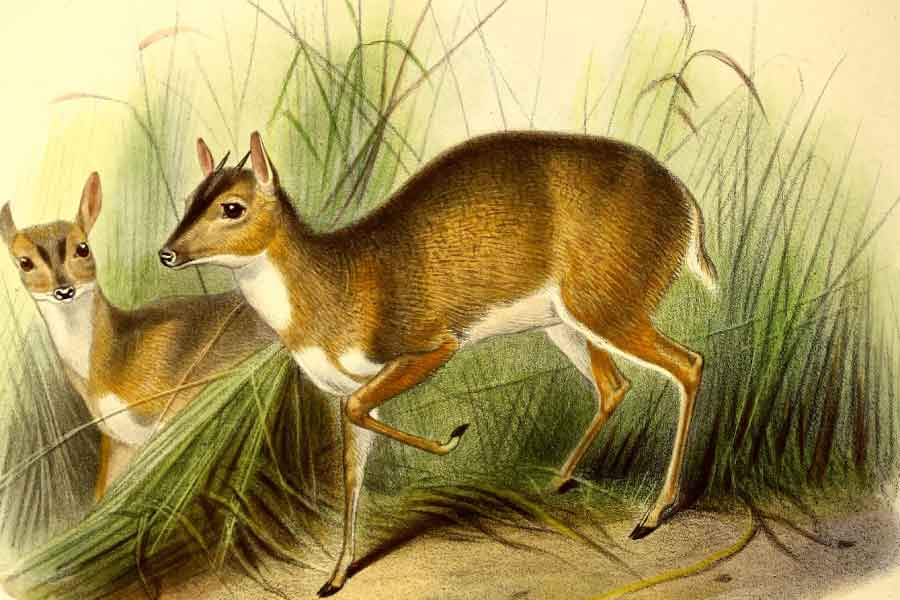
The animal with the shortest horns is the royal antelope, Neotragus pygmaeus. This species, which is also the world’s smallest antelope, is found in the Upper Guinean forests of West Africa. Its horns, which are short, backwards-curving spikes, reach a maximum length of just 3 cm / 1.18 inches.
The conservation status of the royal antelope is Least Concern.
Which Animal Has The Most Horns?
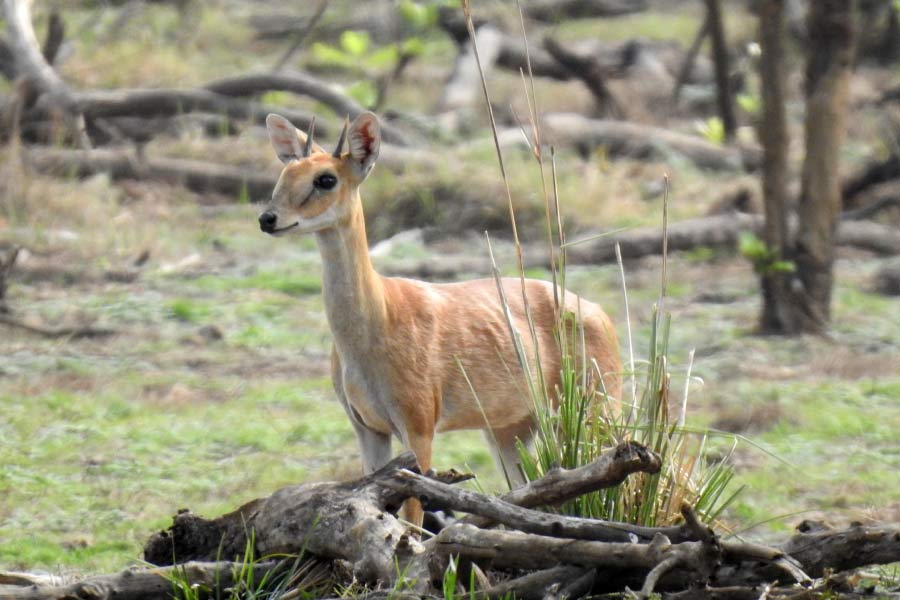
Although nearly all horned animals have just a single pair of horns, a very small number of animals have two pairs of horns. These include the four-horned antelope, Tetracerus quadricornis, a small antelope found in India and Nepal, and the Jacob sheep – a British breed of domestic sheep.
Horns Vs Antlers

Whereas horns are permanent structures that continue to grow throughout an animal’s lifetime, antlers are shed and regrown annually.
Horns have a central core of bone, which is surrounded by a keratinized sheath; antlers are bony structures that grow very quickly, then “die” and eventually fall off.
- Horns are found on members of the family Bovidae, which includes animals such as cattle, bison, antelopes, sheep, goat, ibexes and muskoxen.
- Antlers are found on members of the deer family, Cervidae, which includes animals such as elk, moose and reindeer. (The reindeer is the only female animal that grows antlers; in all other deer species, antlers are only found on males.)
You can see more animals with antlers on this page: Animals With Antlers
Why Do Animals Have Horns?
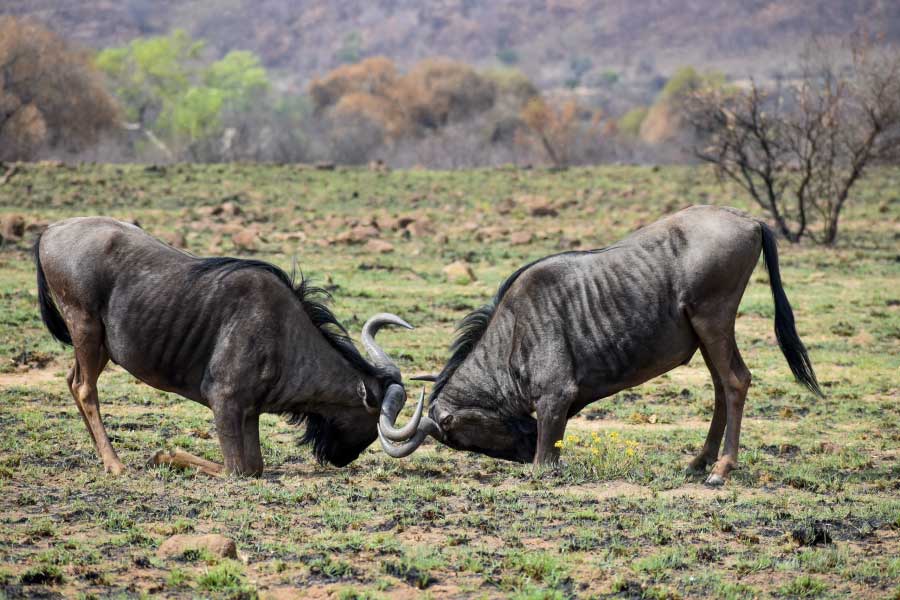
Animal horns have three main uses: as weapons, for display, and as rudimentary scraping or digging tools.
Horns are used as weapons both as defense against predators, and also to fight other animals of the same species – most commonly by males to assert dominance over rival males during the mating season.
Animals with thick, strongly-curved horns, such as bighorn sheep, typically fight by butting, while those with long, gradually-curved horns fight by interlocking their horns and wrestling.
The horns of some animal species are used for display purposes, serving as a visual demonstration of an individual’s health and condition.
An animal may also use its horns to root in the earth for food.
Below is a list of animals with some of the most amazing horns in the animal kingdom…
Examples Of Animals With Horns
Addax
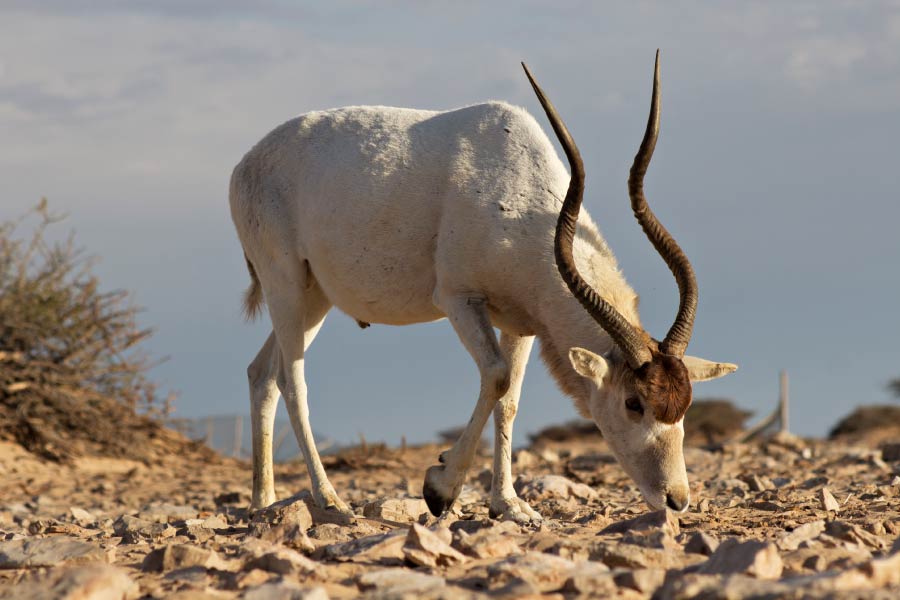
Scientific name: Addax nasomaculatus
Conservation status: Critically Endangered
Max horn length: 1 m / 3.28 ft.
The addax is an antelope found in Africa’s Sahara Desert. It is also known as the screwhorn antelope, on behalf of its long, gently spiraled horns.
This large, slow-moving desert antelope is able to survive for long periods away from a water source, getting all the water it needs from plants. Its pale coat reflects the sun’s heat.
Overhunting is the principal cause of the addax’s Critically Endangered status. It is thought that there are fewer than 90 adult addaxes left in the wild.
Discover More With Active Wild
You can see more desert animals on this page: Desert Animals List with Pictures & Facts
Discover more about the Sahara Desert on this page: Sahara Desert Facts
African Buffalo
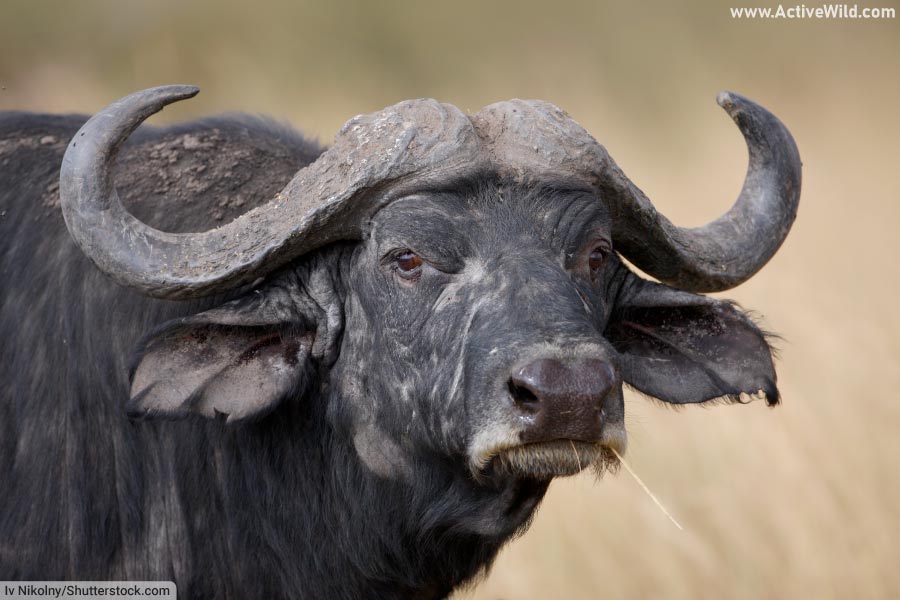
Scientific name: Syncerus caffer
Conservation status: Near Threatened
Max horn length: 1 m / 3.28 ft.
The African buffalo is a long-bodied, powerfully-built animal whose formidable horns are joined in the middle to from a bony shield known as a “boss”. The largest-known distance between the tips of the animal’s curved horns is 1.64 m / 5.38 ft.
A short-tempered and unpredictable animal, the African buffalo is one of Africa’s most dangerous species. It is responsible for over 200 human fatalities each year.
Discover More With Active Wild
You can find out more about the African buffalo on this page: African Buffalo Facts
You can see more African animals on this page: African Animals List with Pictures & Facts
Alpine Ibex
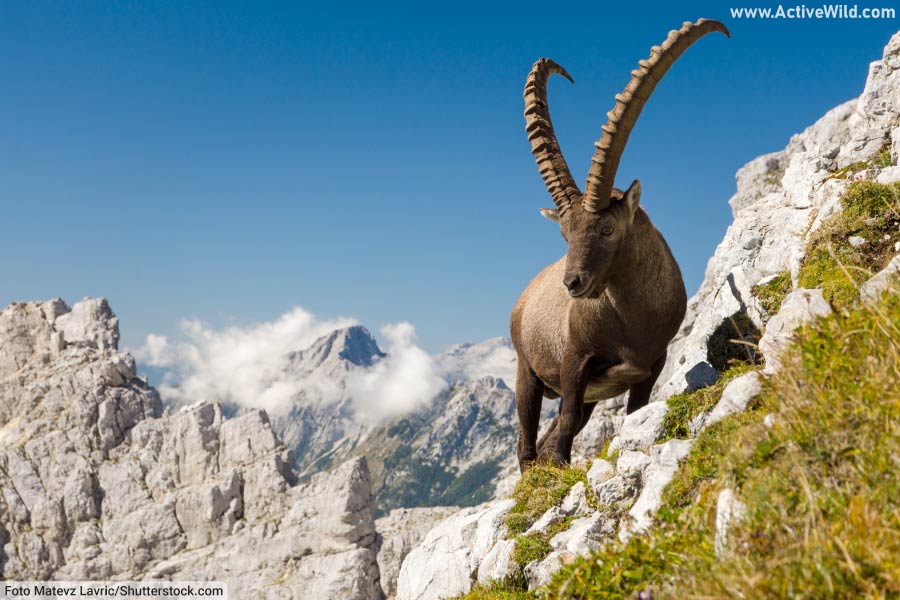
Scientific name: Capra ibex
Conservation status: Least Concern
Max horn length: 0.98 m / 3.22 ft.
The Alpine ibex is one of five species of ibex, all of which are members of the genus Capra, which is home to goats and related animals. The Alpine ibex is found in the Italian Alps, where it lives on rocky slopes above the treeline.
Like all ibexes, the Alpine ibex has extremely long, curved and ridged horns. Both male and females have horns, although those of the male are far heavier and longer.
Discover More With Active Wild
Discover more amazing mountain animals on this page: Mountain Animals List
American Bison / Buffalo
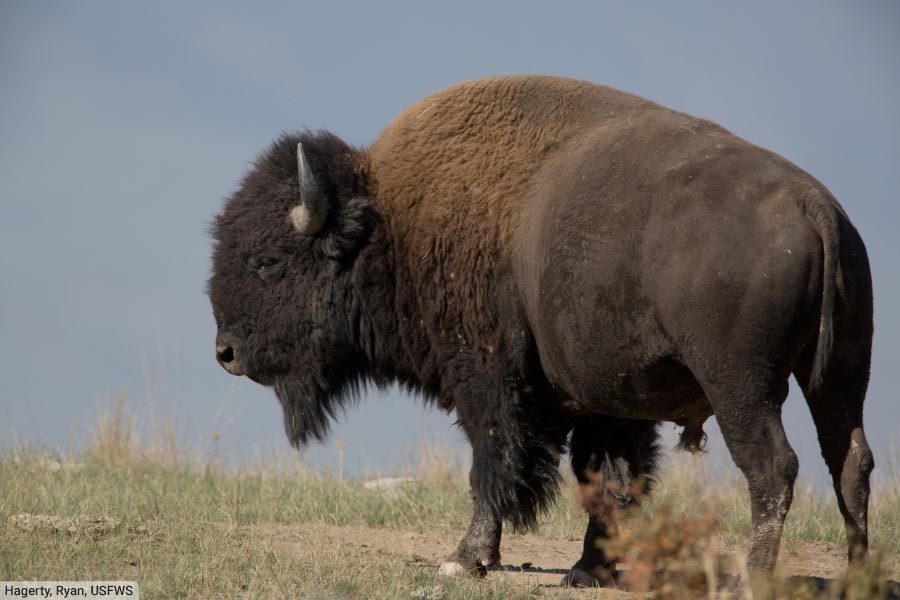
Scientific name: Bison bison
Conservation status: Near Threatened
Max horn length: 0.61 m / 2 ft.
The American bison is one of North America’s iconic species. In terms of both weight and body length, this huge and powerfully-built species is the continent’s largest land animal. The heaviest-recorded American bison weighed 1,270 kg / 2,800 lb.; about the same as a modern compact family car.
Both male and female American bison have horns, which can reach lengths of up to 2 ft / 61 cm.
The American bison is one of two bison species, the other being the European bison, which, while being slightly taller, weighs slightly less on average than the American species.
The American bison is also known as the buffalo, although it is not closely-related to “true” buffalo such as the African buffalo or water buffalo.
Discover More With Active Wild
You can find out more about the American bison on this page: American Bison Facts
Discover more amazing North American animals on this page: North American Animals List with Pictures & Facts
Bharal / Blue Sheep
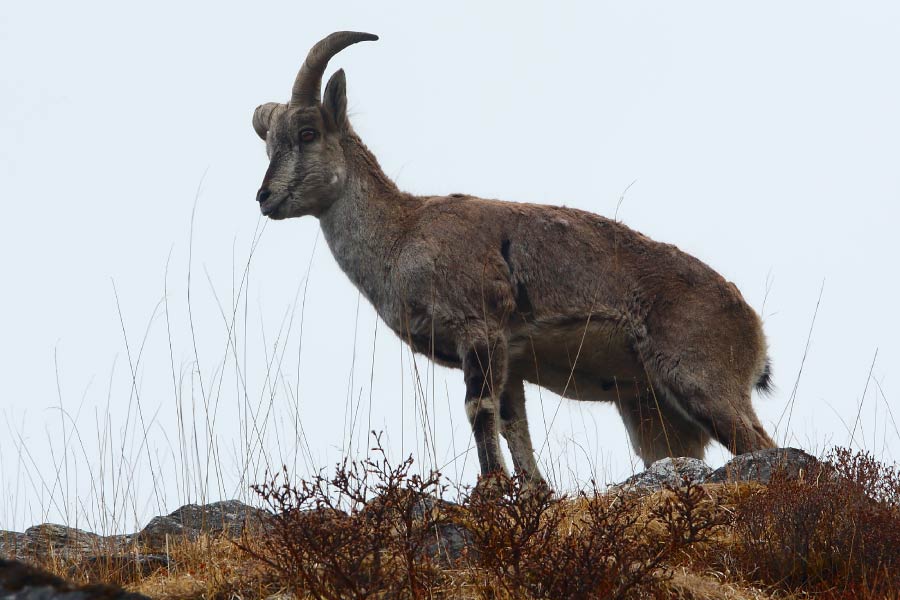
Scientific name: Pseudois nayaur
Conservation status: Least Concern
Max horn length: 0.8 m / 2.62 ft.
Also known as the blue sheep, the bharal is a goat-like animal found in the Himalayas mountain range of Asia.
This hardy animal is able to tolerate extremes of both heat and cold, and lives in large flocks in meadows above the treeline. Its main predator is the snow leopard.
The bharal is a member of the Bovidae subfamily Caprinae, whose members are known as caprines, or goat-antelopes (although they are not true antelopes). The subfamily Caprinae also contains the true goats of genus Capra.
Male bharals have impressive, ridged horns that curve outwards and backwards. The horns of females are shorter and straighter, goring to lengths of around 20 cm / 7.9 in.
Discover More With Active Wild
Discover more amazing mountain animals on this page: Mountain Animals List
You can see more Asian animals on this page: Asian Animals List with Pictures & Facts
Bighorn Sheep
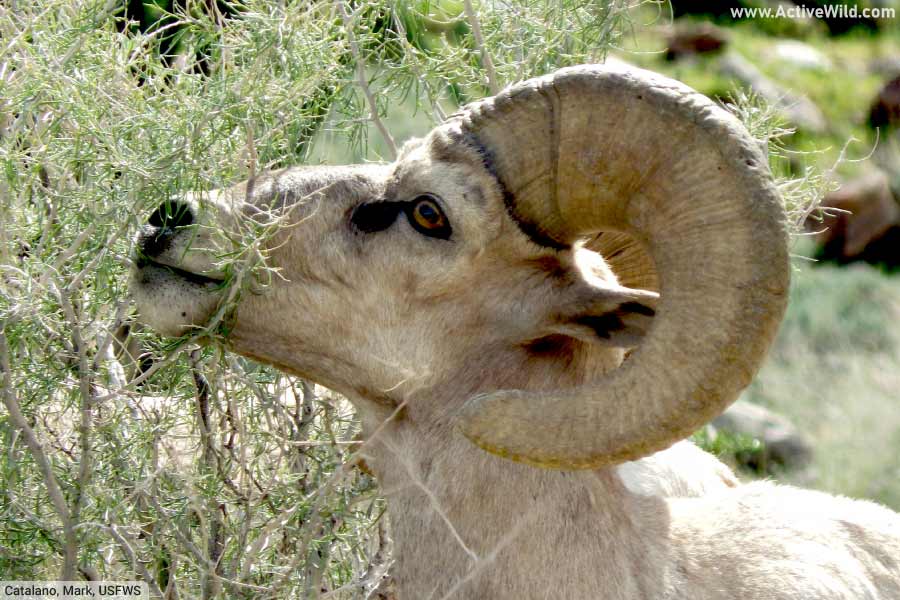
Scientific name: Ovis canadensis
Conservation status: Least Concern
Max horn length: 0.96 m / 3.17 ft.
Sheep arrived in North America around 750,000 years ago, after crossing the Bering land bridge from Siberia. From these first sheep have evolved the two living North American sheep species: the Dall sheep Ovis dalli, and the bighorn sheep.
Bighorn sheep are named for the large horns of the males (the females too have horns, but they are shorter and less curved). The males use their horns as “battering rams” in fights for dominance within the herd prior to the mating season.
Bighorn sheep are found in mountainous, grassland and rocky habitats in western Canada, USA, and parts of Mexico.
You can find out more about the bighorn sheep on this page: Bighorn Sheep Facts
Discover more amazing North American animals on this page: North American Animals List with Pictures & Facts
Cattle
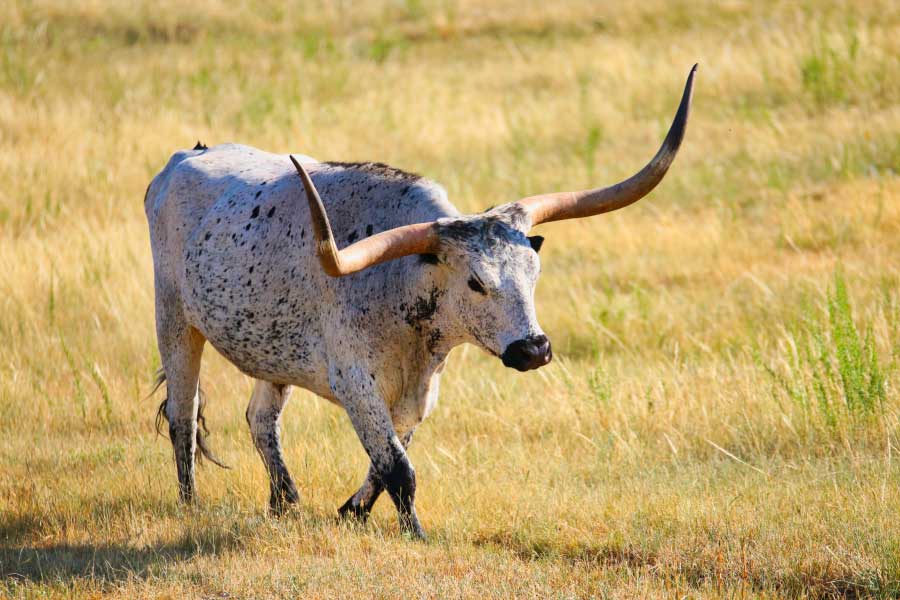
Scientific name: Bos taurus
Conservation status: Domestic
Max horn length: 1.4 m / 4.59 ft.
Cattle are large bovids that were first domesticated around 10,500 years ago. Although there is great variation in the size and appearance of living cattle, all are the same species, Bos taurus.
Domestic cattle are descended from a now-extinct wild bovid, the aurochs. The last known aurochs died in 1627.
Discover More With Active Wild
Find out more about mammals on this page: Mammals - The Ultimate Guide
Four-Horned Antelope

Scientific name: Tetracerus quadricornis
Conservation status: Vulnerable
Max horn length: 0.012 m / .039 ft.
The four-horned antelope is extremely unusual among horned animals, having four, instead of the normal two, horns. (Another notable example of an animal with four-horns is the Jacob sheep – a breed of sheep from England.)
A hind pair of horns are positioned between the four-horned antelope’s ears, while a front pair are positioned on the forehead. The front pair of horns, with a maximum length of 5 cm / 1.97 in., are considerably shorter than the hind pair, which are over twice as long. Only males have horns.
One of the smallest horned animals in Asia, the four-horned antelope is found in forest habitats in India and Nepal.
Discover More With Active Wild
You can see more Asian animals on this page: Asian Animals List with Pictures & Facts
Gaur / Indian Bison
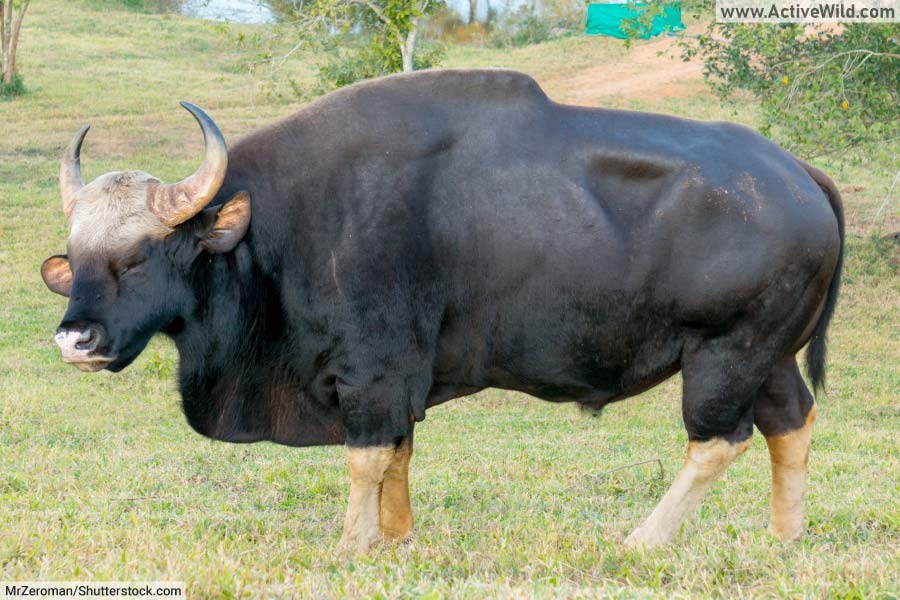
Scientific name: Bos gaurus
Conservation status: Vulnerable
Max horn length: 1.15 m / 3.77 ft.
The gaur is the world’s largest living horned animal, with males (which are around 25% heavier than females) reaching weights of over 1,500 kg / 3,307 lb. – well over the weight of a typical compact car. Both male and female gaurs have horns; those of the male reach lengths of up to 1.15 m / 3.77 ft.
Due to its size and strength, the gaur has few predators. The only animals large enough to attack a full-grown gaur are the saltwater crocodile and the tiger, although such attacks are rare; without the benefit of surprise, an attack on a gaur carries the risk of injury or death.
The gaur is found in South and Southeast Asia, where it inhabits forests and grasslands. It is threatened both by hunting and habitat loss.
Discover More With Active Wild
You can see more Asian animals on this page: Asian Animals List with Pictures & Facts
Gemsbok
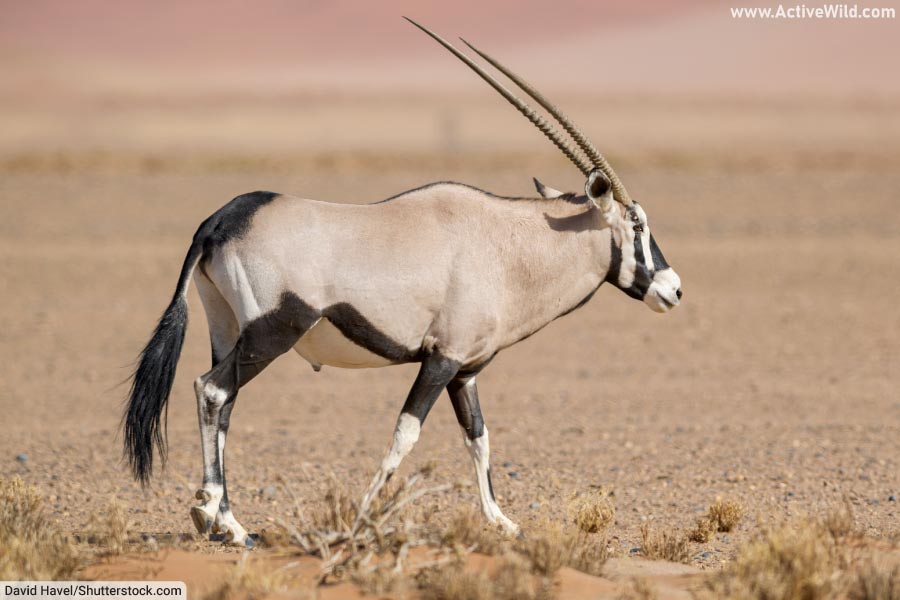
Scientific name: Oryx gazella
Conservation status: Least Concern
Max horn length: 0.85 m / 2.79 ft.
The gemsbok is a large antelope of genus Oryx. Also known as the South African oryx, the species is found in the southern African countries Botswana, Namibia, South Africa and Zimbabwe. It inhabits deserts, savannas and grasslands.
Unusually among animals with horns, female gemsbok often have longer horns than males.
Discover More With Active Wild
You can see more desert animals on this page: Desert Animals List with Pictures & Facts
You can see more African animals on this page: African Animals List with Pictures & Facts
Giant Eland
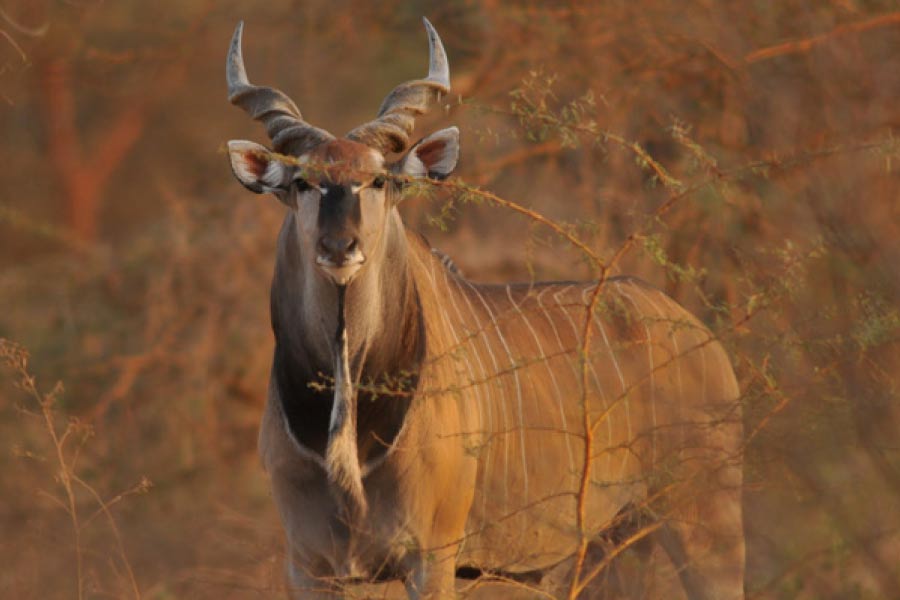
Scientific name: Taurotragus derbianus / Tragelaphus derbianus
Conservation status: Vulnerable
Max horn length: 1.23 m / 4.04 ft.
The giant eland is an antelope found in forests and savannas in Africa south of the Sahara Desert.
With a body length of up to 2.9 m / 9.51 ft, and weight of up to 1,200 kg / 2,650 lb., the giant eland is the world’s largest antelope.
This distinctive species has a reddish-brown coat marked with narrow, vertical white stripes. Its horns, which reach 1.23 m / 4.04 ft in length, have a spiraled, “corkscrew”-like appearance. Although both males and female giant elands have horns, those of the male are almost twice the length of the female’s.
Discover More With Active Wild
You can see more African animals on this page: African Animals List with Pictures & Facts
Greater Kudu
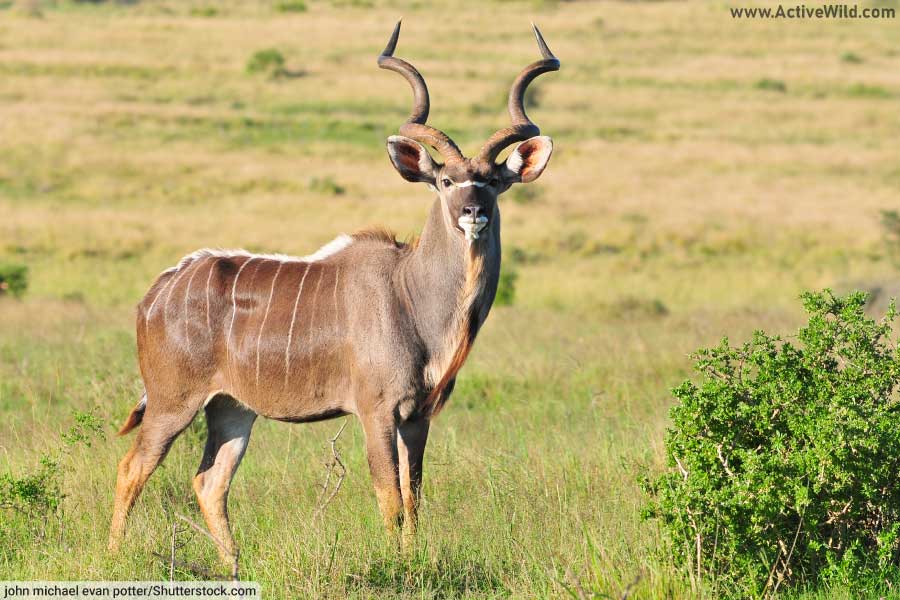
Scientific name: Tragelaphus strepsiceros
Conservation status: Least Concern
Max horn length: 1.2 m / 3.94 ft.
The long, pointed and gently spiraled horns of the greater kudu are among the most impressive in the animal kingdom. The horns of a full-grown male have 2.5 twists and are over 1 m / 3.28 ft. in length.
Slightly larger than the related lesser kudu, the greater kudu is one of the largest antelope species. It is found in eastern and southern Africa.
Only male kudus have horns, which are used to wrestle other males to establish dominance. Occasionally, the horns of two fighting males become locked together, which can result in the death of both combatants.
Discover More With Active Wild
You can see more African animals on this page: African Animals List with Pictures & Facts
Impala
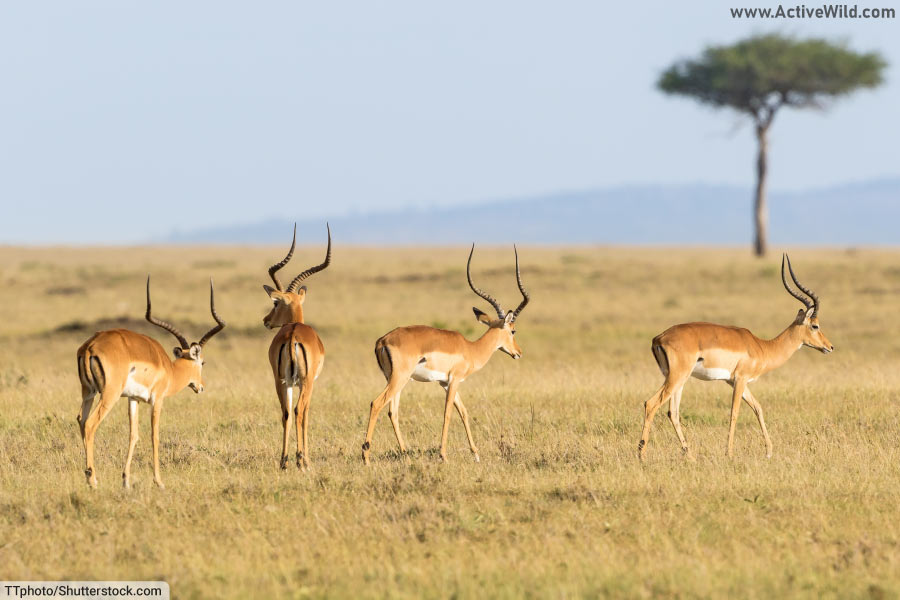
Scientific name: Aepyceros melampus
Conservation status: Least Concern
Max horn length: 0.92 m / 3.02 ft.
The horns of the male impala are ridged and gently spiraled, growing outwards then inwards to form a distinctive lyre shape. The female lacks horns, but, like the male, is sandy-red in color.
This graceful antelope is found in eastern and southern Africa, where it inhabits light woodlands and savannas.
Impalas live in herds that can contain up to 100 individuals. Social grooming is common among the species. When threatened, impalas leap continuously to confuse potential predators.
Discover More With Active Wild
You can see more African animals on this page: African Animals List with Pictures & Facts
Markhor
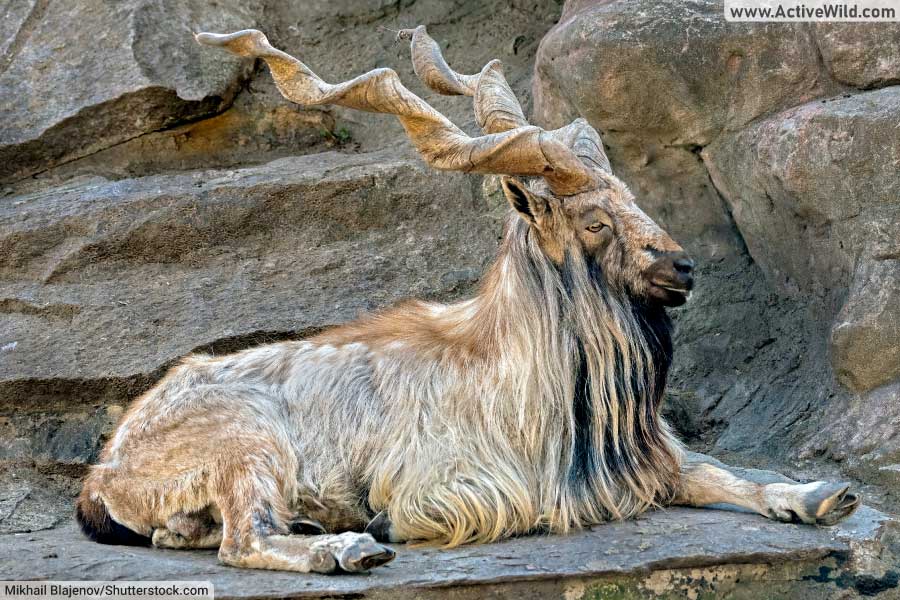
Scientific name: Capra falconeri
Conservation status: Near Threatened
Max horn length: 1.6 m / 5.25 ft.
The markhor is a member of the goat genus Capra found in Central Asia. It lives at high altitudes on mountainous, rocky terrain, and is present on both the Karakoram and Himalaya mountain ranges. The species is the national animal of Pakistan.
The markhor is also known as the “screw horn” on behalf of the distinctive, cork-screw-shaped horns of the male.
Predators of the markhor include the wolf, snow leopard, and Eurasian lynx.
Discover More With Active Wild
You can see more Asian animals on this page: Asian Animals List with Pictures & Facts
Discover more amazing animals that live on mountains on this page: Mountain Animals List with Pictures & Facts
Mouflon
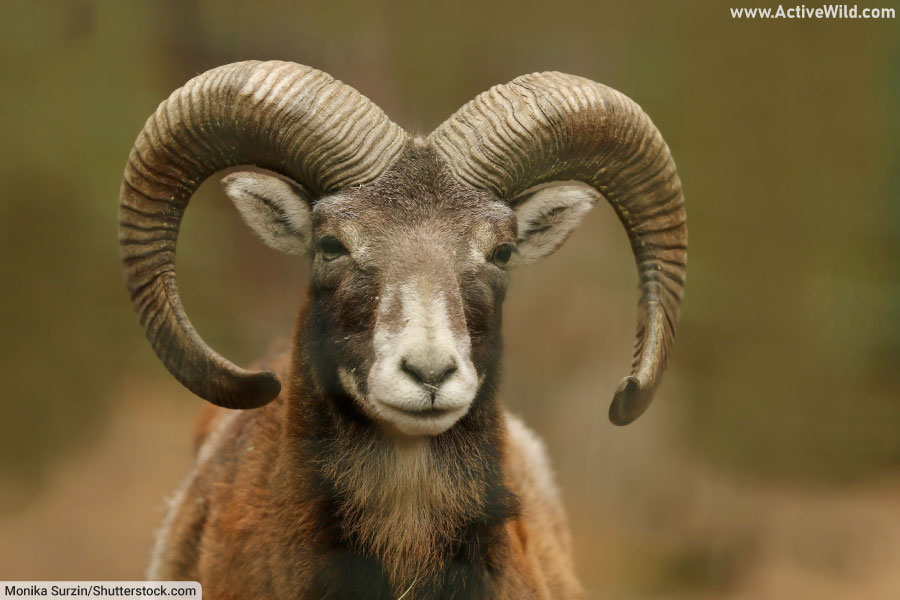
Scientific name: Ovis gmelini
Conservation status: Near Threatened
Max horn length: 0.85m / 2.79 ft.
The mouflon is a wild sheep, which, like all sheep, belongs to the genus Ovis. The mouflon is believed to be the ancestor of all domestic sheep.
Sheep were first domesticated between 11,000 and 9,000 B.C., and were among the first animals to be domesticated (dogs may have been the first).
The mouflon is found in several west Asian countries, including Turkey, Iran and Armenia. It lives in mountainous regions.
The horns of the ram are sturdy, growing outwards and curving round in an almost complete revolution.
Discover More With Active Wild
You can see more Asian animals on this page: Asian Animals List with Pictures & Facts
Discover more amazing animals that live on mountains on this page: Mountain Animals List with Pictures & Facts
Nubian Ibex
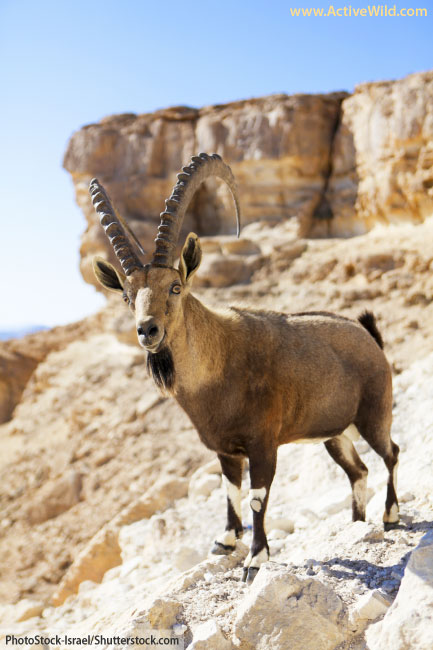
Scientific name: Capra nubiana
Conservation status: Vulnerable
Max horn length: 1 m / 3.28 ft.
The Nubian ibex is a member of the goat genus Capra found in northwest Africa and parts of the Middle East. It inhabits desert mountains, and like all goats, is an accomplished climber of steep, rocky slopes.
The long, heavily-ridged, and backwards-curving horns of the Nubian ibex reach lengths of 1 m / 3.28 ft.
Predators of the Nubian ibex include leopards, wolves and red foxes.
Discover More With Active Wild
You can see more Asian animals on this page: Asian Animals List with Pictures & Facts
Discover more amazing animals that live on mountains on this page: Mountain Animals List with Pictures & Facts
Pronghorn
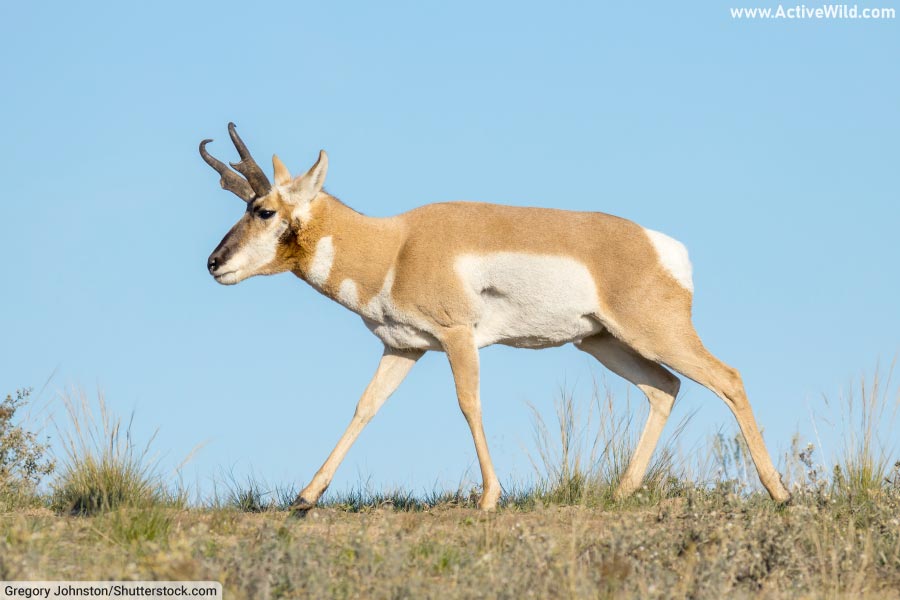
Scientific name: Antilocapra americana
Conservation status: Least Concern
Max horn length: 0.43 m / 1.41 ft.
The pronghorn is the only living member of the family Antilocapridae. Although also known as the “American antelope”, the pronghorn is more closely-related to the giraffe and okapi than it is to the antelopes and other horned animals of family Bovidae.
The pronghorn is named for the shape of the male’s horns, which have a prong-like projection at the front.
The horns of the pronghorn are different to those of bovids such as antelope, cattle, etc., in that the keratinous sheath covering the bone is shed and regrown each year.
Capable of running at speeds of up to 88.5 km/h / 55.0 mph, the pronghorn is the world’s third-fastest land animal, after the cheetah and ostrich.
Discover More With Active Wild
You can find out more about the pronghorn on this page: Pronghorn Facts
Discover more amazing North American animals on this page: North American Animals List with Pictures & Facts
Scimitar Oryx
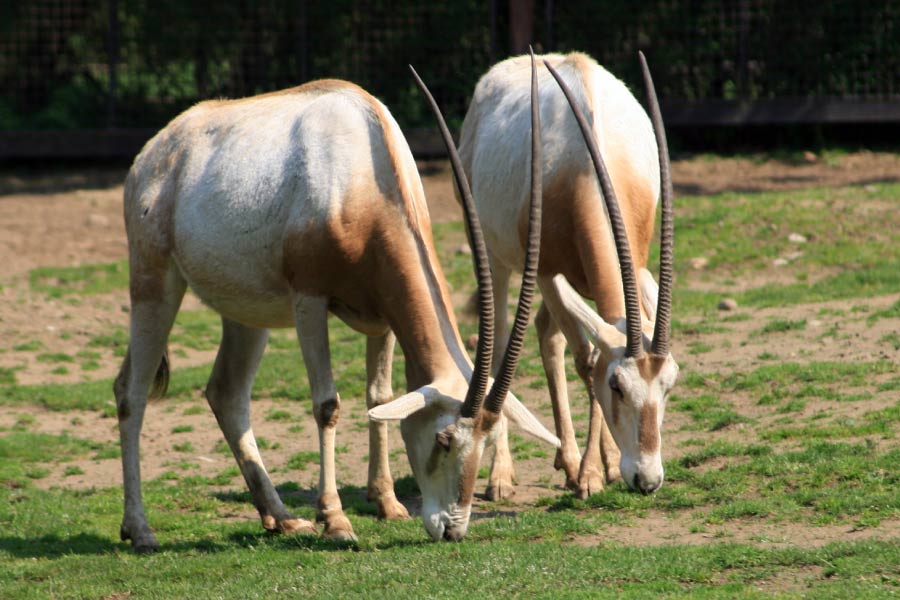
Scientific name: Oryx dammah
Conservation status: Extinct In The Wild
Max horn length: 1.2 m / 3.94 ft.
Up to one million scimitar oryx may once have roamed in and around the Sahara Desert in Africa between 9.5 and 4.5 thousand years ago. Today, the species is extinct in the wild, surviving only in captivity. The species’ decline is due both to overhunting and habitat loss.
The long, thin and slightly-curved horns of the scimitar oryx are the longest of any oryx, reaching 1.2 m / 3.94 ft. in length. The species, which appears to have a single horn when viewed from the side, may have been responsible for the unicorn myth.
Discover More With Active Wild
You can see more desert animals on this page: Desert Animals List with Pictures & Facts
Discover more about the Sahara Desert on this page: Sahara Desert Facts
You can see more African animals on this page: African Animals List with Pictures & Facts
Royal Antelope

Scientific name: Neotragus pygmaeus
Conservation status: Least Concern
Max horn length: 0.03 m / 0.10 ft.
The royal antelope is not only the world’s smallest antelope, it is also the animal with the smallest horns.
This tiny species, which stands just 25 cm / 9.8 in. tall at the shoulder, is found in the Upper Guinea Forest of western Africa. Its horns, which are found only on the male, reach a maximum length of just 3 cm / 1.18 in.
Discover More With Active Wild
You can see more African animals on this page: African Animals List with Pictures & Facts
Saiga
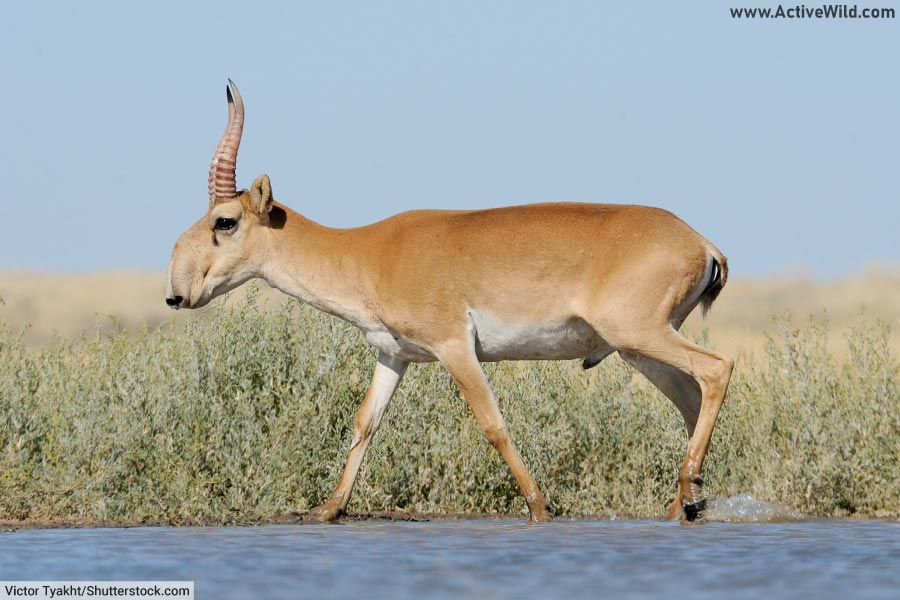
Scientific name: Saiga tatarica
Conservation status: Critically Endangered
Max horn length: 0.38 m / 1.25 ft.
The saiga is an antelope found on steppes (dry grasslands) and deserts in Asia. The species is present in four countries: Kazakhstan, Mongolia, Russian Federation and Uzbekistan.
Only male saigas have horns, which are ringed and gently lyre-shaped. During the mating season, rival males fight for control of groups of females known as “harems”.
It may look odd to our eyes, but the saiga antelope’s unusual nose helps the animal to survive in the barren steppe habitat. Those large nostrils filter out dust, cool the antelope in the summer and warm up the air in the winter.
Once found in vast herds, the saiga was heavily hunted until just one thousand individuals remained. Today, the species is critically endangered.
Discover More With Active Wild
You can see more unusual-looking animals on this page: Ugly Animals Pictures & Facts
You can see more desert animals on this page: Desert Animals List with Pictures & Facts
Water Buffalo
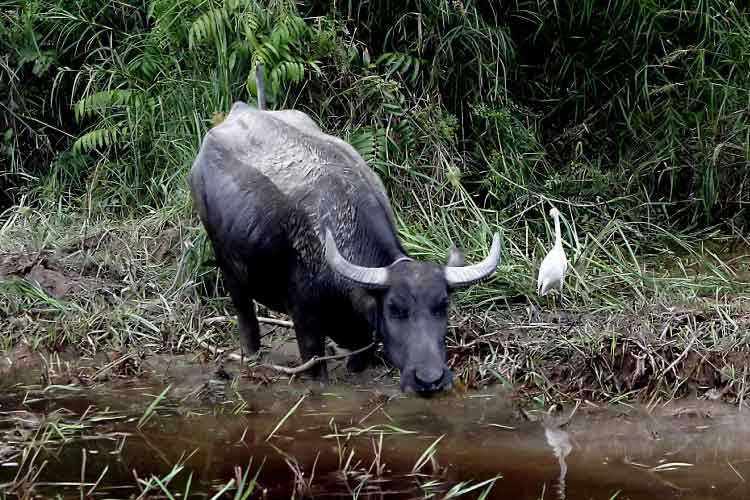
Scientific name: Bubalus bubalis
Conservation status: Domesticated
Max horn length: 1.52 m / 4.99 ft.
The water buffalo, also known as the Asian water buffalo, is a domestic animal kept in Asia and many other parts of the world.
The species is thought to have evolved from the wild water buffalo, Bubalus arnee.
Both the wild and the domestic water buffalo belong to the cattle family, Bovidae. This group is home to domestic cattle and other hooved animals such as antelopes, buffaloes and yaks.
The water buffalo is employed in numerous tasks, including pulling farm machinery and providing milk. It is also a source of meat.
You can find out more about the water buffalo on this page: Water Buffalo Facts
Discover More With Active Wild
You can find out more about the water buffalo on this page: Water Buffalo Facts
You can see more Asian animals on this page: Asian Animals List with Pictures & Facts
Wild Water Buffalo / Asian Water Buffalo

Scientific name: Bubalus arnee
Conservation status: Endangered
Max horn length: 2 m / 6.56 ft.
Also known as the Asian buffalo, the wild water buffalo is found in southern Asia, from India to Thailand. The species is closely associated with water, as is typically found in grasslands, forests and woodlands near rivers. It spends much of its time wallowing in water and mud.
The wild water buffalo has the longest horns of any animal. Reaching lengths of up to 2 m / 6.56 ft., the buffalo’s horns grow out to the sides before curving backwards.
Larger than the domestic water buffalo, and only slightly smaller than the gaur, the wild water buffalo is one of the heaviest animals with horns.
The wild water buffalo is an endangered species. One of the main threats to the species is interbreeding with domestic water buffalo.
Discover More With Active Wild
You can see more Asian animals on this page: Asian Animals List with Pictures & Facts
You can find out more about the water buffalo on this page: Water Buffalo Facts
Animals With “Horns” That Aren’t Horns
Rhino

Although rhinos are famous for their horns, a rhino horn is not a “true” horn such as those found in animals of family Bovidae.
Instead of having a bony inner core, a rhino’s horn is made entirely of keratin (the substance out of which hair is also made).
Like the horns of a bovid, a rhino’s horn grows continuously, and is not shed like a deer’s antlers.
There are five living species of rhinoceros; the white, black and Sumatran rhinos each have two horns; the Indian and Javan rhinos have one.
Discover More With Active Wild
You can find out more about rhinos on this page: Rhino Facts
Find out more about the white rhino on this page: White Rhino Facts
Find out more about the black rhino on this page: Black Rhino Facts
Deer
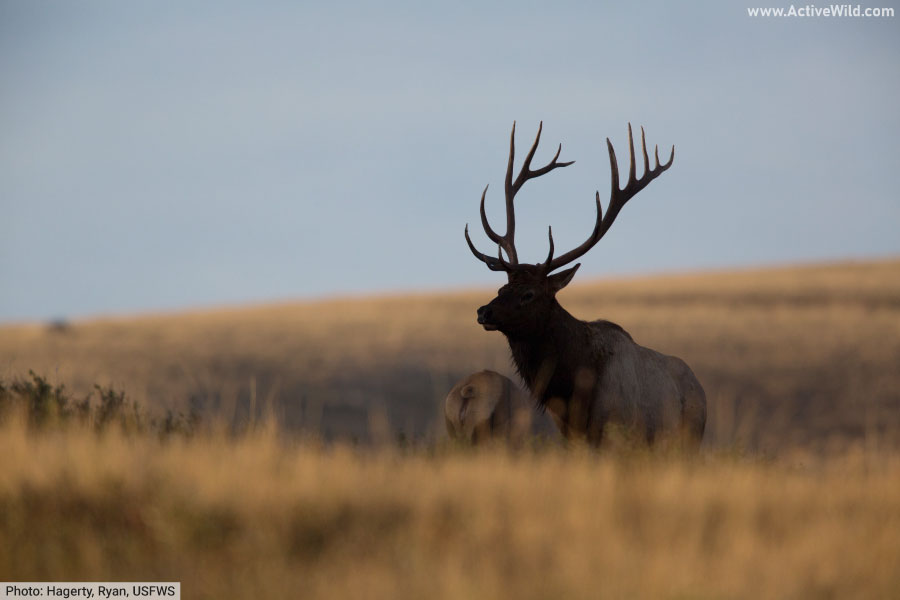
Deer, including well-known species such as elk, moose and reindeer, have antlers, rather than horns. Although used in similar ways to horns, antlers differ significantly in the way in which they grow. The difference between antlers and horns is described further up the page.
Discover More With Active Wild
You can find out more about animals with antlers on these pages:
Giraffe & Okapi
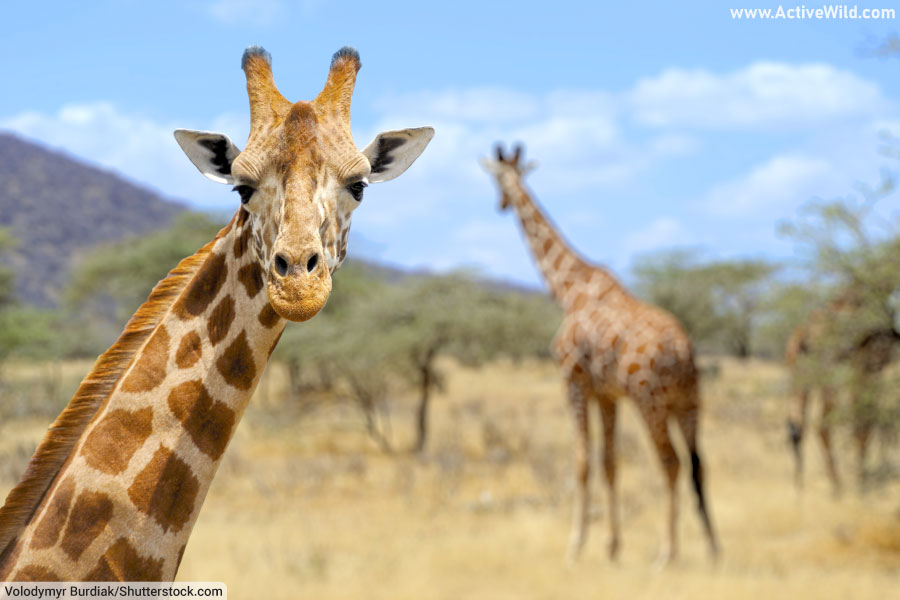
The giraffe and the okapi are the only living member of the family Giraffidae.
The giraffe, famous for being the world’s tallest animal, lives in the savannas and woodlands of sub-Saharan Africa.
The lesser-known, and endangered, okapi is found only in forests of the Democratic Republic of the Congo.
Both the giraffe and the okapi have horn-like projections known as ossicones. Like the horns of bovids, ossicones are made of bone, but they differ from horns in that they are permanently covered with skin and hair.
Discover More With Active Wild
You can find out more about the giraffe on this page: Giraffe Facts
You can find out more about the okapi on this page: Okapi Facts
Horned Lizards
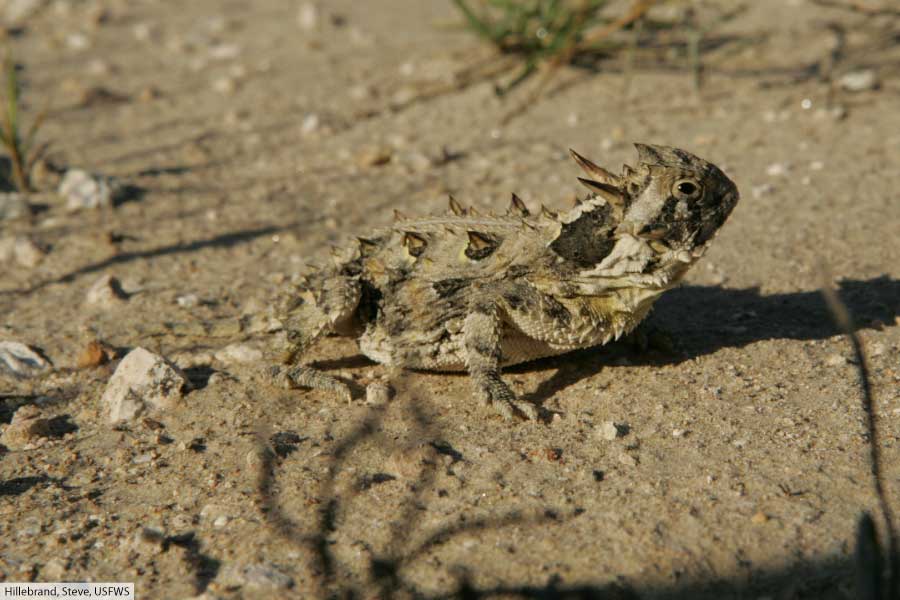
The 21 horned lizard species together form the genus Phrynosoma. Like a mammal’s horn, the horns of these reptiles have bony centers that are sheathed in keratin. Because of this similarity, the horns of horned lizards can be considered “true” horns.
Horned lizards are found in North America, usually in deserts or other dry areas. Several horned lizards are able to project blood from their eyes, which is used as defense against predators.
Discover More With Active Wild
You can find out more about reptiles on this page: Reptiles - The Ultimate Guide
Discover more amazing American reptiles on this page: American Reptiles List with Pictures & Facts
Horned Owls
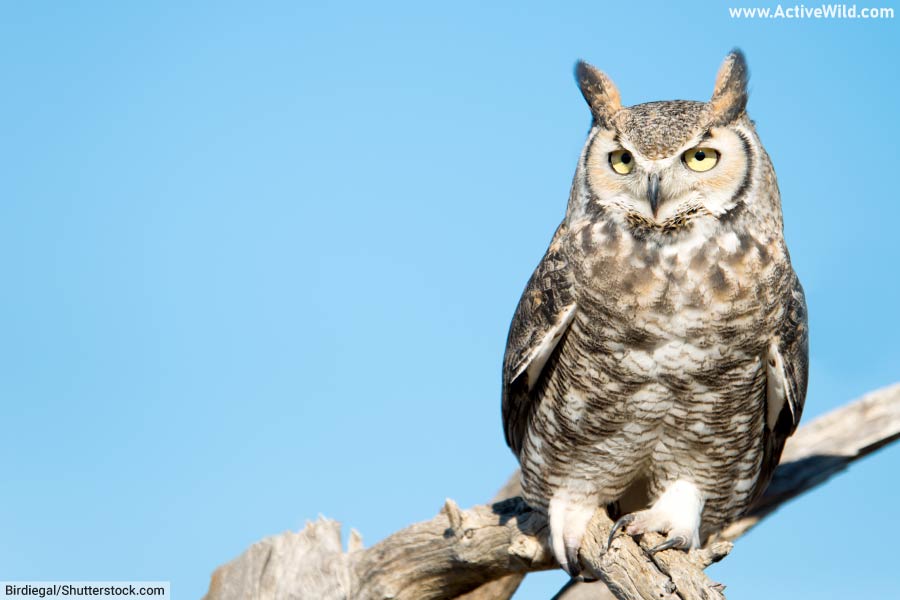
The great and lesser horned owls are North American members of the genus Bubo. The “horns” after which they are named aren’t horns at all, but tufts of feathers which project upwards either side of the bird’s heads.
Discover More With Active Wild
You can find out more about the great horned owl on this page: Great Horned Owl Facts
Discover more amazing nocturnal animals on this page: Nocturnal Animals List with Pictures & Facts
Horned Vipers

Horned vipers are snakes of genus Cerastes. The “horns” of horned vipers aren’t true horns, but modified scales located above each eye.
Two species – Cerastes cerastes and Cerastes gasperettii of the three species in the genus are known to have these “horns”. The modified scales may help to keep sand out of the snakes’ eyes, or may be a means of camouflaging the snake while it is hunting.
Discover More With Active Wild
You can find out more about snakes on this page: Snakes - The Ultimate Guide
Discover amazing snake facts on this page: Fun Facts On Snakes
Jackson’s Chameleon / Three-Horned Chameleon
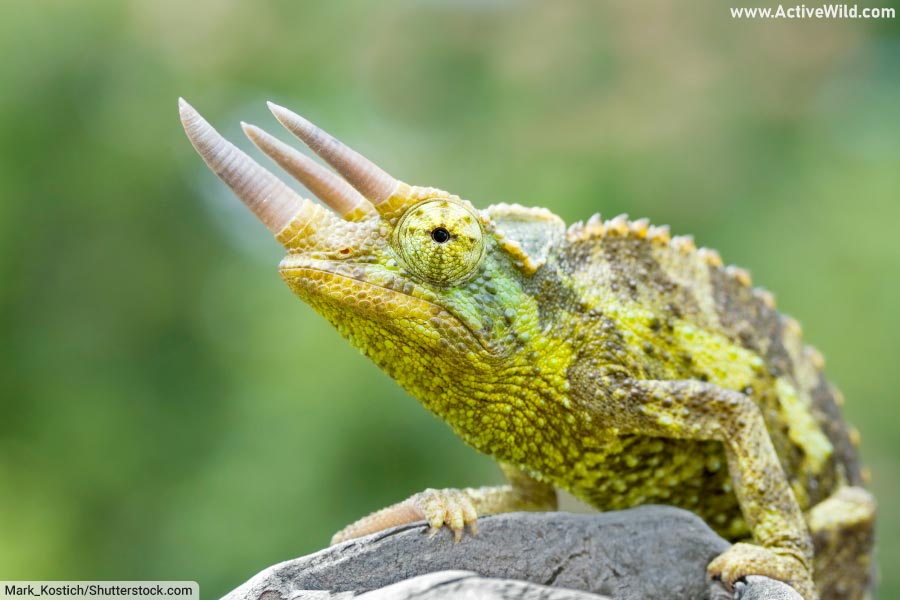
Jackson’s chameleon Trioceros jacksonii is a reptile in the chameleon family, Chamaeleonidae. This East African reptile is known for its distinctive three-horned appearance, and is also known as the three-horned chameleon.
Although, armed with its three horns, Jackson’s chameleon looks dangerous, fights between rival males are usually settled by posturing, rather than by actual fighting.
Discover More With Active Wild
You can find out more about reptiles on this page: Reptiles - The Ultimate Guide
Discover more amazing reptiles on this page: Types Of Reptiles
You can see more ugly animals on this page: Ugly Animals List with Pictures & Facts
Further Reading: Discover More With Active Wild
Discover amazing animals from all around the world here: A to Z Animals
Become an animal expert: Animals – The Complete Guide To The Animal Kingdom
Find out more about words such as “species” and “family” on this page: Animal Classification

